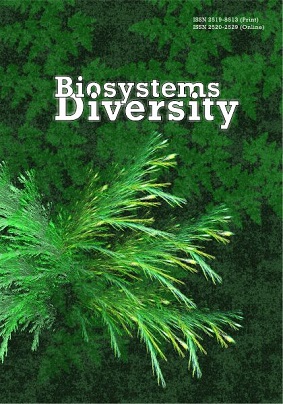Effect of crystalline and amorphic phenol on characteristics of peptidases and glycosidases in chironomid larvae
Effect of crystalline and amorphic phenol on characteristics of peptidases and glycosidases in chironomid larvae
Author(s): V. V. Kuz’mina, E.Y. Chornaya, E.A. Kulivatskaya, G. V. Zolotareva, V.A. SheptitskiySubject(s): Agriculture, Health and medicine and law, Sociobiology, Environmental interactions
Published by: Дніпропетровський національний університет імені Олеся Гончара
Keywords: amorphous phenol; chironomid larvae; glycosidases; peptidases; enzyme characteristics;
Summary/Abstract: The effects of crystalline and amorphous phenol (0.5 mmol/L) on the characteristics of glycosidases, as well as casein-lytic and hemoglobin-lytic peptidases, which function in the whole body of chironomid larvae Chironomus sp. were studied. Crystalline phenol decreased the activity of glycosidases in comparison to the control in the temperature range 0–50 ºС, amorphous phenol – in the temperature range 0–70 ºС. The temperature optimum of glycosidases in whole body of chironomid larvae in control and experiment corresponds to 50 ºС. The activity of glycosidases in comparison to the control decreased in the pH range 5–11 (to a greater extent in the case of the lower fraction). Amorphous phenol increased the activity of casein-lytic peptidases in comparison to the control in the temperature range of 30–50 ºС, hemoglobin-lytic peptidases – in the temperature range of 0–60 ºС. The degree of the increase of enzyme activity in the temperature optimum zone of casein-lytic and hemoglobin-lytic peptidases was different: the level of enzyme activity in the experiment was higher than in the control by 2.3 and 1.8 times, respectively. The temperature optimum of the studied peptidases of chironomid larvae, regardless of the experimental conditions, corresponds to 40 °C. Crystalline phenol did not actually affect the Q10 values of glycosidases in the temperature range 0–50 °C. Amorphous phenol decreased the Q10 values at a temperature of 40–50 °C. The Q10 values of casein-lytic peptidases increased in most cases, the Q10 values of hemoglobin-lytic peptidases decreased in the presence of amorphous phenol. The process of protein hydrolysis was characterized by a break in the Arrhenius plot at 20 °C. The values of Еact in the range 0–20 °С were lower than in the zone of higher temperatures. The Еact values of the process of casein hydrolysis by peptidases of all tissues of chironomid larvae in the presence of amorphous phenol in both temperature zones increased. The Еact values of the process of hemoglobin hydrolysis by peptidases of all tissues of chironomid larvae in the presence of amorphous phenol in both temperature zones decreased. The Еact values of the process of starch hydrolysis in the presence of crystalline phenol decreased. The amorphous phenol changed the Еact values in different directions. They slightly increased in the presence of the phenol upper fraction, but they decreased in the presence of the phenol lower fraction. The data obtained indicate a significant effect of crystalline and amorphous phenol not only on activity, but also on the characteristics of peptidases and glycosidases that function in the whole body of chironomid larvae.
Journal: Biosystems Diversity
- Issue Year: 28/2020
- Issue No: 2
- Page Range: 175-180
- Page Count: 6
- Language: English

